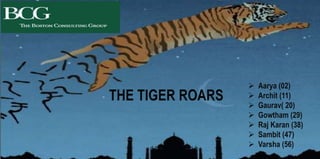Marketing tiger roars
- 1. ï Aarya (02) ï Archit (11) ï Gaurav( 20) ï Gowtham (29) ï Raj Karan (38) ï Sambit (47) ï Varsha (56)
- 2. 4 STRATEGIES SIZE OF THE PRIZE UNDERSTANDING THE PRIZE FINDING THE PRIZE CAPTURING THE PRIZE
- 3. 1.THE SIZE OF THE PRIZE Consumer spending is likely to nearly quadruple by 2020 Items Spending in 2010 ($ billions) Spending in 2020 ($ billion) Food Housing and consumer durables Transportation and communications Clothes and foot wear Education and leisure Health Other Total 328 186 168 71 59 49 129 991 895 3,584 570 183 225 296 664 752 3.6x
- 4. 2. UNDERSTANDING THE PRIZE HOUSEHOLD INCOME:- âĒ India has had a wide range of âstrugglerâ households. âĒ More than one-third of the population is likely to reach âaspirerâ class by 2020 compared with 20% in 2010 and 9% in 2000. âĒ The share of households(strugglers) are earning less than $3,300 which is likely to fall from 51% in 2010 to 28% by 2020.
- 5. URBANIZATION âĒ In 2010, 31% Indiaâs population lived in cities âĒ By 2020, the % will be raised to 35% . As people move from rural areas to cities they tend to increase their expenses âĒ People living in urban areas have better access to goods and are more exposed to consumerism âĒ For Eg-, television is owned by 80% of urban households, whereas in rural households it is only 39%.
- 6. THE NUCLEAR FAMILY âĒ The % of nuclear family increased from 61% in 2006 to 66% in 2010. âĒ A nuclear family spends more on clothing, housing, education and leisure activities whereas they both spend equally on food and health. âĒ The per capita expenditure of these families is 20%-50% higher than that of joint families.
- 7. GEN-I âĒ Economic liberalization in 1991 marked a turning point for India. âĒ They have different believes and have made different choices other than their parents. âĒ The GenâI have far greater choice than prior generations. The number of car models, for example has jumped from about 5 in 1990 to more than 160 today.
- 8. 3. FINDING THE PRIZE âĒProfessional Affluent âĒTraditional AffluentAffluent âĒUrban Aspirers âĒRural AspirersAspirers âĒLarge Town Next Billions âĒSmall Town Next BillionsNext Billions Strugglers
- 9. AFFLUENT : âĒ Annual household income > US $18,500 âĒ This section of the society are well educated, have companies in middle or large scale sectors or good jobs with sufficient income. âĒ This segment constitutes 6% of households in India.
- 10. ASPIRERS âĒ Annual household income between US $ 7,400 and US $ 18,500. âĒ This section of the society are educated, have middle sized businesses or stable jobs with income sufficient to live comfortably.. âĒ This segment constitutes 14% of households in India.
- 11. NEXT BILLION âĒ Annual household income between $ 3,300 and $ 7,400. âĒ They have basic education and have small businesses or hold low paying jobs. âĒ This constitutes 30% of households in India.
- 12. STRUGGLERS âĒ Annual household income < US $ 3,300. âĒ Typically illiterate with limited education. These consumers have jobs that are manual labour. âĒ Strugglers are generally based on daily wages.
- 13. Graph
- 16. 4. CAPTURING THE PRIZE. For companies to invest in a developing country like India, they need to have a deep understanding to capture the market. Hence, they need the following two strategies to achieve the same. 1. Follow an Indian Market Approach :- âĒ Consumption Pattern. âĒ Lifestyle. âĒ Attitudes and Behavior. âĒ Financial Maturity.
- 17. UNDERSTANDING THE EVOLUTION OF CONSUMPTION TREND âĒ Children : Driving consumption growth. âĒ Internet wave. âĒ Trading up. âĒ Brand : Strong recognition, weak loyalty. âĒ Healthy living.
- 18. CONCLUSION The consumers spending in India is rising by leaps and bounds and if a company comes to India and tries to capture it without adequate preparation they are likely to fall short. India is a big and growing consumer market but not a easy one .Thus the Tiger Roars report gives a good insight about the consumer habits and their spending in different fields . Hence we can say that India which was once a pyramid is rapidly turning into a diamond.



















